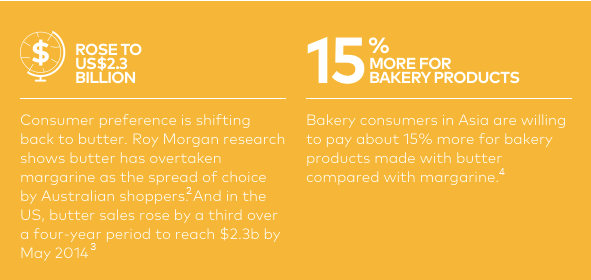Butter vs margarine: A tale of two fats
Cafe
Aug 28, 2018
4 mins read
Customers keen on eating natural foods would be hard-pressed to find one as pure as butter.
Margarine manufacturers have long tried to recreate the incomparable taste of butter, but haven’t been successful.
Here’s why:

Butter’s flavour is near-impossible to imitate because its complex combination of flavour compounds occur naturally.

Some of those compounds are only released when heated, giving cooking and baking the buttery flavour consumers know and love.

Because butter melts at a normal body temperature, it also delivers an excellent round mouthfeel and flavour. Margarine doesn’t melt at that same temperature, which is why it leaves a lingering, greasy after-taste.

It’s now accepted that saturated fats have a more neutral effect on cholesterol, as opposed to trans fats, which increase ‘bad’ and reduce ‘good’ cholesterol.2 This solidifies the renewed belief that butter has its place in a balanced diet
These differences between butter and margarine come down to the processes in which each are made.

Butter is made from cream derived from milk – and nothing else. And with the aid of modern machines, the traditional butter-making process has become faster with a more consistent production.

Margarine is made from vegetable oil that has gone through a hydrogenation process, resulting in the presence of unhealthy trans fats. It also has to be artificially coloured and flavoured.

1. Mozzaffarian, D., Katan, MB., Ascherio, A., Stampfer, MJ., & Willett WC. Trans fatty acids and cardiovascular disease. N Engl J Med. 13 Apr 2006; 354(15):1601–13.
2. Inside FMCG. The tables have churned. 20 May 2015. https://insidefmcg.com.au
3. Nielson Research, May 2014. Cited by: Gee, K. Butter makes comeback as margarine loses favor. The Wall Street Journal, 25 June 2014.
4. Kadence International Research